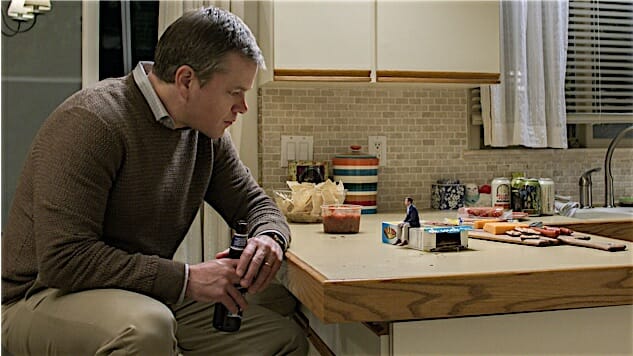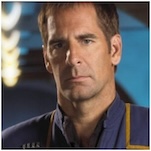Downsizing

Over his two-decade career, filmmaker Alexander Payne has returned again and again to his favorite satirical subject: the foibles of middle-aged white guys. With the exception of his 1996 debut Citizen Ruth, men have been the focus of this two-time Oscar-winner, who has a knack for analyzing their hang-ups, mocking their insecurities and sometimes feeling their pain. Often, men in his movies behave badly, letting their pride or anxieties get the best of them, although Payne often provides them with a soft landing. These guys aren’t all bad—they mean well, but often can’t get out of their own way.
In a movie year in which the most talked-about films have also been the most inclusive—Get Out, The Big Sick, Wonder Woman, Lady Bird—Payne’s mopey white men can’t help but feel a little passé: “Geez, another film about a middle-aged dude pondering his insignificance? What’s more to say?” His latest doesn’t entirely satisfyingly answer those questions, but it’s certainly his most ambitious—both in terms of its premise and where the film ultimately goes. The best anyone can say about Downsizing is that it shows Payne trying to push himself into new terrain. And the worst is that the movie finds him struggling to find new variations on his familiar themes.
The movie stars Matt Damon as Paul, who lives in a near future when science has made an incredible breakthrough: In the face of catastrophic global overpopulation, there is now a technology that can shrink people down to five inches. The implications are endless. Think of how much this will help overcrowding—not to mention reduce everybody’s food and clothing budget.
Excited about the prospect, Paul and his wife Audrey (Kristen Wiig) decide to sign up for the procedure, which will mean moving from Omaha to a resort exclusively for miniaturized people known as Leisureland. The couple are understandably a little anxious, but it seems like a great way to reinvigorate their lives and relationship. Paul goes through the process and comes out unscathed, prepared to start this new chapter—only to learn that Audrey has gotten cold feet, opting to stay normal size and abandon her husband.
Heartbreak is a common refrain in Payne’s movies, but it’s not quite as central in Downsizing, which has a lot on its mind—ultimately, perhaps too much. He and longtime cowriter Jim Taylor haven’t just hit upon a clever idea but also given some thought to how it would play out in the real world. The introduction of miniature citizens creates a new kind of elite—it’s a pricey procedure, after all—but Payne really twists the knife when he reveals what Leisureland is like. Imagine the tackiest tourist trap—a faux-classy, ultra-artificial beachside resort—and you’ll have an idea of what awaits Paul. At the movies, we’ve encountered dozens of dystopian visions in recent years, but few are as cheerfully, chillingly banal as the one depicted in Downsizing. It’s frightening because it’s so corporately constructed—and then it’s even more frightening because the people who have signed up consider it paradise.
Payne grounds the proceedings in the same small-town modesty that’s always been a hallmark of his work. (Downsizing is easily 2017’s most blasé sci-fi film.) He’s operating on a larger thematic canvas this time, though. As Paul tries to navigate life as a miniaturized person without Audrey, he starts to unearth the less-savory elements of this seemingly squeaky-clean community. A minority underclass has started to form in the slums, while the richest, most obnoxious elites—especially Christoph Waltz’s playboy twit Dusan Mirkovic—treat their lives like one never-ending party.
-

-

-

-

-

-

-

-

-

-

-

-

-

-

-

-

-

-

-

-

-

-

-

-

-

-

-

-

-

-

-

-

-

-

-

-

-

-

-

-








































